Number of Lines of Image Reconstructed from a Revealing Emission Signal as an Important Parameter of Rasterization and Coherent Summation Processes
Abstract
1. Introduction
- Propose another dedicated measure and its criterion, effective in correctly determining the number of lines of the reconstructed image from the registered revealing broadcast signal;
- Pre-processing the reconstructed image depending on the B number of lines, and then analysing it in accordance with the adopted measure.
2. Conditions of Conducted Tests
2.1. Test Images
2.2. Test Conditions
2.3. Algorithm of the Determining the Correct Number Lines of Image
3. Methods of Determining of Image Number Lines
3.1. Introduction
3.2. Methods of Evaluating Contrast of Reconstructed Images
- ,
- ,
- ,
- …,
- ,
- …,
- ,
- ,
- ,
- selected measures that allow for the selection of the value that meets the adopted criterion, which is the maximum value. It corresponds to the correct number of lines of the reconstructed image.
3.2.1. Contrast Evaluation Based on the Value of the Average Amplitude of Pixels of the Reconstructed Image—Method I
- —columns number of reconstructed image;
- —number of columns of reconstructed image ( 0, 1, 2,…, );
- —rows number (lines) of reconstructed image calculated according to (1);
- —number of rows (lines) of reconstructed image ( 0, 1, 2,…, );
- —value of image pixel amplitude for coordinates ;
- —the maximum value of the image pixel amplitude for the number B line;
- —the minimum value of the image pixel amplitude for the number B line.
3.2.2. Contrast Evaluation Based on the Maximum and Minimum Values of the Amplitude of Pixels of the Reconstructed Image—Method II
3.2.3. Contrast Evaluation Based on the Sum of the Differences between Adjacent Image Pixels—Method III
3.2.4. Contrast Evaluation Based on the Variance of the Grey Levels of the Reconstructed Image—Method IV
3.3. Methods Proposed by Authors
3.3.1. The Maximum Value of the Difference between the Maximum and Minimum Pixel Amplitude Sums Calculated for Each Vertical Line of the Reconstructed Image—Method V
3.3.2. The Minimum Value of the Sum of the Differences of the Maximum and Minimum Amplitudes Calculated for Individual Vertical Lines of the Reconstructed Image—Method VI
3.3.3. The Minimum Value of the Sum of the Maximum Pixel Amplitudes Calculated for the Individual Vertical Lines of the Reconstructed Image—Method VII
4. Test Results
4.1. HDMI Standard as a Source of Reveal Emissions—Sample Images
4.1.1. Primary Image in the Form of the Photo Presented in Figure 7a (, 195,364,892)
4.1.2. Primary Image in the Form of the Text Presented in Figure 7b (, 741,466,826)
4.2. VGA Standard as a Source of Reveal Emissions—Sample Image
Primary Image in the Form of the Text Presented in Figure 7c (, 259,256,078)
4.3. Display of Multifunctional Device as a Source of Reveal Emissions—Sample Image
Primary Image in the Form of Menu Presented in Figure 7d (, 93,127,351)
4.4. The Analysis of Obtained Results
5. Conclusions
Author Contributions
Funding
Institutional Review Board Statement
Informed Consent Statement
Data Availability Statement
Conflicts of Interest
References
- Aydın, H. TEMPEST attacks and cybersecurity. Int. J. Eng. Technol. 2019, 5, 100–104. [Google Scholar]
- Fakiha, B. Business organization security strategies to cyber security threats. Int. J. Saf. Secur. Eng. 2021, 11, 101–104. [Google Scholar] [CrossRef]
- Fakiha, B. Effectiveness of forensic firewall in protection of devices from cyberattacks. Int. J. Saf. Secur. Eng. 2022, 12, 77–82. [Google Scholar] [CrossRef]
- De Meulemeester, P.; Scheers, B.; Vandenbosch, G.A.E. A quantitative approach to eavesdrop video display systems exploiting multiple electromagnetic leakage channels. IEEE Trans. Electromagn. Compat. 2020, 62, 663–672. [Google Scholar] [CrossRef]
- Ho Seong, L.; Jong-Gwan, Y.; Kyuhong, S. Analysis of information leakage from display devices with LCD. In Proceedings of the URSI Asia-Pacific Radio Science Conference 2016, Seoul, Republic of Korea, 21–25 August 2016. [Google Scholar]
- Mahshid, Z.; Saeedeh, H.T.; Ayaz, G. Security limits for electromagnetic radiation from CRT display. In Proceedings of the Second International Conference on Computer and Electrical Engineering, Dubai, United Arab Emirates, 28–30 January 2009; pp. 452–456. [Google Scholar]
- Boitan, A.; Bartusica, R.; Halunga, S.; Popescu, M.; Ionuta, I. Compromising electromagnetic emanations of wired USB keyboards. In Proceedings of the Third International Conference on Future Access Enablers for Ubiquitous and Intelligent Infrastructures (FABULOUS), Bucharest, Romania, 12–14 October 2017. [Google Scholar]
- Choi, D.H.; Lee, E.; Yook, J.G. Reconstruction of video information through leakaged electromagnetic waves from two VDUs using a narrow band-pass filter. IEEE Access 2022, 10, 40307–40315. [Google Scholar] [CrossRef]
- Zhang, N.; Yinghua, L.; Qiang, C.; Yiying, W. Investigation of unintentional video emanations from a VGA connector in the desktop computers. IEEE Trans. Electromagn. Compat. 2017, 59, 1826–1834. [Google Scholar] [CrossRef]
- Kubiak, I.; Loughry, J. LED arrays of laser printers as valuable sources of electromagnetic waves for acquisition of graphic data. Electronics 2019, 8, 1078. [Google Scholar] [CrossRef]
- De Meulemeester, P.; Scheers, B.; Vandenbosch, G.A.E. Eavesdropping a (ultra-)high-definition video display from an 80 meter distance under realistic circumstances. In Proceedings of the 2020 IEEE International Symposium on Electromagnetic Compatibility & Signal/Power Integrity (EMCSI), Reno, NV, USA, 27–31 July 2021. [Google Scholar]
- Levina, A.; Mostovoi, R.; Sleptsova, D.; Tcvetkov, L. Physical model of sensitive data leakage from PC-based cryptographic systems. J. Cryptogr. Eng. 2019, 9, 393–400. [Google Scholar] [CrossRef]
- Kuhn, M.G. Compromising Emanations: Eavesdropping Risks of Computer Displays; University of Cambridge Computer Laboratory: Cambridge, UK, 2003. [Google Scholar]
- Maxwell, M.; Funlade, S.; Lauder, D. Unintentional compromising electromagnetic emanations from IT equipment: A concept map of domain knowledge. Procedia Comput. Sci. 2022, 200, 1432–1441. [Google Scholar]
- Przybysz, A.; Grzesiak, K.; Kubiak, I. Electromagnetic safety of remote communication devices—Videoconference. Symmetry 2021, 13, 323. [Google Scholar] [CrossRef]
- Mehdaoui, Y.; El Alami, R. DSP implementation of the Discrete Fourier Transform using the CORDIC algorithm on fixed point. Adv. Model. Anal. B 2018, 61, 123–126. [Google Scholar] [CrossRef]
- Morales-Aguilar, S.; Kasmi, C.; Meriac, M.; Vega, F.; Alyafei, F. Digital images preprocessing for optical character recognition in video frames reconstructed from compromising electromagnetic emanations from video cables. In Proceedings of the URSI GASS 2020, Rome, Italy, 29 August–5 September 2020. [Google Scholar]
- Bartusica, R.; Boitan, A.; Fratu, O.; Mihai, M. Processing gain considerations on compromising emissions. In Proceedings of the Conference: Advanced Topics in Optoelectronics, Microelectronics and Nanotechnologies 2020, Constanta, Romania, 20–23 August 2020. [Google Scholar]
- Song, T.L.; Jong-Gwan, J. Study of jamming countermeasure for electromagnetically leaked digital video signals. In Proceedings of the IEEE International Symposium on Electromagnetic Compatibility, Gothenburg, Sweden, 1–4 September 2014. [Google Scholar]
- De Meulemeester, P.; Scheers, B.; Vandenbosch, A.E. Reconstructing video images in color exploiting compromising video emanations. In Proceedings of the International Symposium on Electromagnetic Compatibility-EMC EUROPE, Rome, Italy, 23–25 September 2020. [Google Scholar] [CrossRef]
- Meynard, O.; Réal, D.; Guilley, S.; Flament, F.; Danger, J.L.; Valette, F. Characterization of the electromagnetic side channel in frequency domain. In Proceedings of the Information Security and Cryptology International Conference—Lecture Notes in Computer Science, Shanghai, China, 20–24 October 2010; Abstract No. 6584. pp. 471–486. [Google Scholar]
- Hee-Kyung, L.; Yong-Hwa, K.; Young-Hoon, K.; Seong-Cheol, K. Emission security limits for compromising emanations using electromagnetic emanation security channel analysis. IEICE Trans. Commun. 2013, 96, 2639–2649. [Google Scholar]
- Jun, S.; Yongacoglu, A.; Sun, D.; Dong, W. Computer LCD recognition based on the compromising emanations in cyclic frequency domain. In Proceedings of the IEEE International Symposium on Electromagnetic Compatibility, Ottawa, ON, Canada, 25–29 July 2016; pp. 164–169. [Google Scholar]
- Mao, J.; Liu, P.; Liu, J.; Shi, S. Identification of multi-dimensional electromagnetic information leakage using CNN. IEEE Access 2019, 7, 145714–145724. [Google Scholar] [CrossRef]
- Li, Y.; Fan, H.; Huang, W. The application of the duffing oscillator to detect electromagnetic leakage emitted by HDMI cables. In Proceedings of the IEEE International Joint EMC/SI/PI and EMC Europe Symposium, Raleigh, NC, USA, 26 July–13 August 2021. [Google Scholar] [CrossRef]
- Efendioglu, H.S.; Asik, U.; Karadeniz, C. Identification of computer displays through their electromagnetic emissions using support vector machines. In Proceedings of the International Conference on Innovations in Intelligent Systems and Applications (INISTA), Novi Sad, Serbia, 24–26 August 2020. [Google Scholar] [CrossRef]
- Kubiak, I. The influence of the structure of useful signal on the efficacy of sensitive emission of laser printers. Measurement 2018, 119, 63–74. [Google Scholar] [CrossRef]
- Kubiak, I.; Przybysz, A. Measures and correctness criteria for determining the length of the image line of data obtained in the process of electromagnetic infiltration. Appl. Sci. 2022, 12, 10384. [Google Scholar] [CrossRef]
- Boitan, A.; Kubiak, I.; Halunga, S.; Przybysz, A.; Stanczak, A. Method of colors and secure fonts in aspect of source shaping of valuable emissions from projector in electromagnetic eavesdropping process. Symmetry 2020, 12, 1908. [Google Scholar] [CrossRef]
- Prvulovic, M.; Zajic, A.; Callan, R.L.; Wang, C.J. A method for finding frequency-modulated and amplitude-modulated electromagnetic emanations in computer systems. IEEE Trans. Electromagn. Compat. 2017, 59, 34–42. [Google Scholar] [CrossRef]
- Kubiak, I.; Przybysz, A. FFT and Chirp-Z transforms as methods of determining image raster parameters. In Proceedings of the 39th IBIMA Computer Science Conference, Granada, Spain, 30–31 May 2022. [Google Scholar]
- Ciecholewski, M. An algorithm to the pseudo-coloring of medical scans. Electr. Electron. Eng. 2008, 24, 1–6. [Google Scholar]
- Bal, A. Comparison of selected contrast evaluation methods of grey level images. PAK 2010, 56, 501–503. [Google Scholar]
- Kubiak, I.; Przybysz, A.; Musial, S. Possibilities of electromagnetic penetration of displays of multifunction devices. Computers 2020, 9, 62. [Google Scholar] [CrossRef]
- Trip, B.; Butnariu, V.; Vizitiu, M.; Boitan, A.; Halunga, S. Analysis of compromising video disturbances through power line. Sensors 2022, 22, 267. [Google Scholar] [CrossRef] [PubMed]
- Yan, X.; Song, X. An image recognition algorithm of bolt loss in underground pipelines based on local binary pattern operator. Traitement Du Signal 2020, 37, 679–685. [Google Scholar] [CrossRef]
- Odeh, A.; Odeh, M.; Odeh, H.; Odeh, N. Hand-written text recognition methods: Review study. Rev. D’intelligence Artif. 2022, 36, 333–339. [Google Scholar] [CrossRef]
- Sathishkumar, B.S.; Nagarajan, G. An efficient algorithm for computer tomography in low radiation images. Adv. Model. Anal. B 2018, 61, 189–197. [Google Scholar] [CrossRef]
- Zhang, Z.; Xie, X. Application of image processing and identification technology for digital archive information management. Traitement Du Signal 2022, 39, 145–152. [Google Scholar] [CrossRef]
- Ahmed, A.I.; Baykara, M. Digital image denoising techniques based on multi-resolution wavelet domain with spatial filters: A review. Traitement Du Signal 2021, 38, 639–651. [Google Scholar] [CrossRef]
- Wang, H. Three-dimensional image recognition of athletes’ wrong motions based on edge detection. J. Eur. Des Syst. Autom. 2020, 53, 733–738. [Google Scholar] [CrossRef]
- Joshi, S.; Karule, P.T. Review of preprocessing techniques for fundus image analysis. Adv. Model. Anal. B 2019, 60, 593–612. [Google Scholar] [CrossRef]

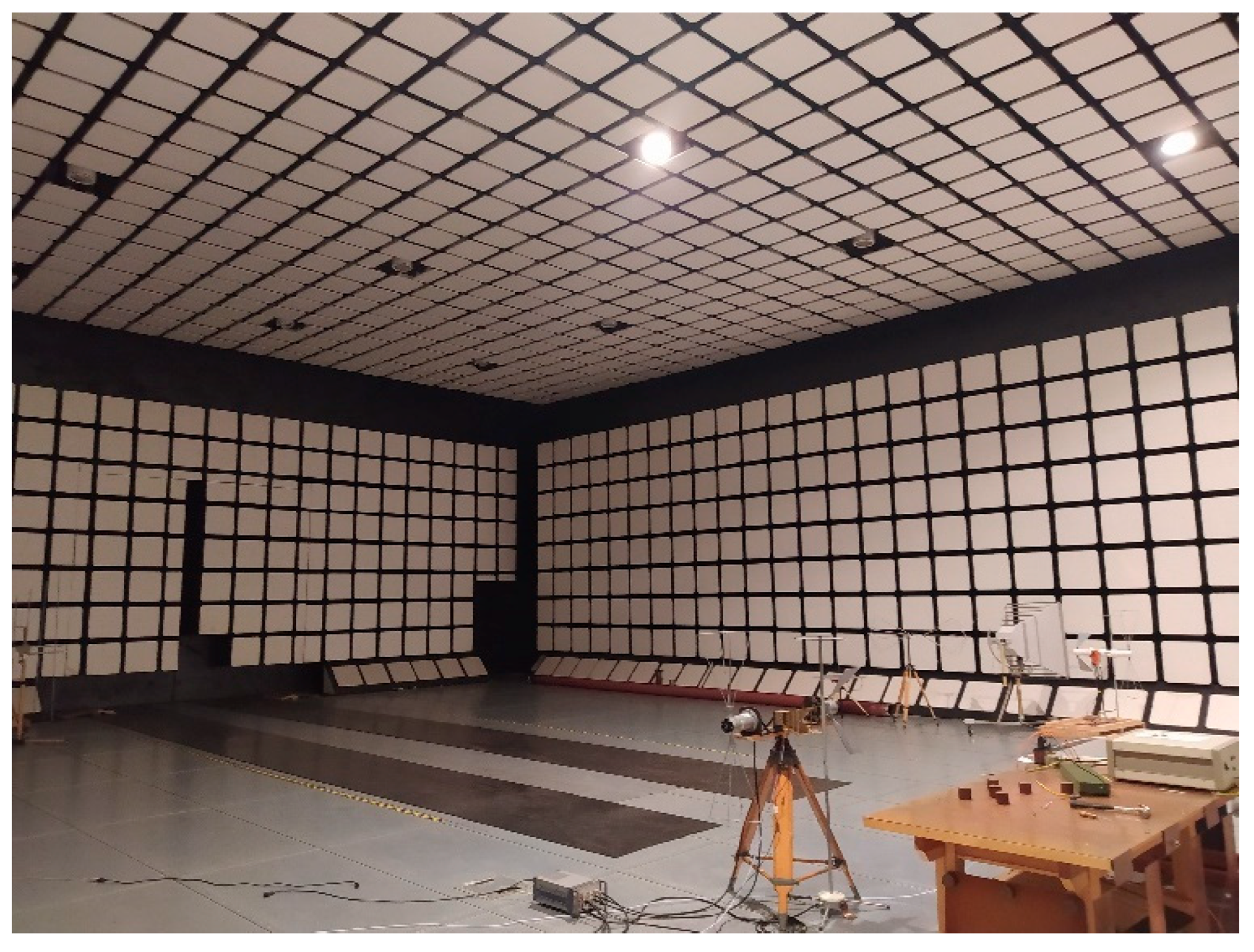

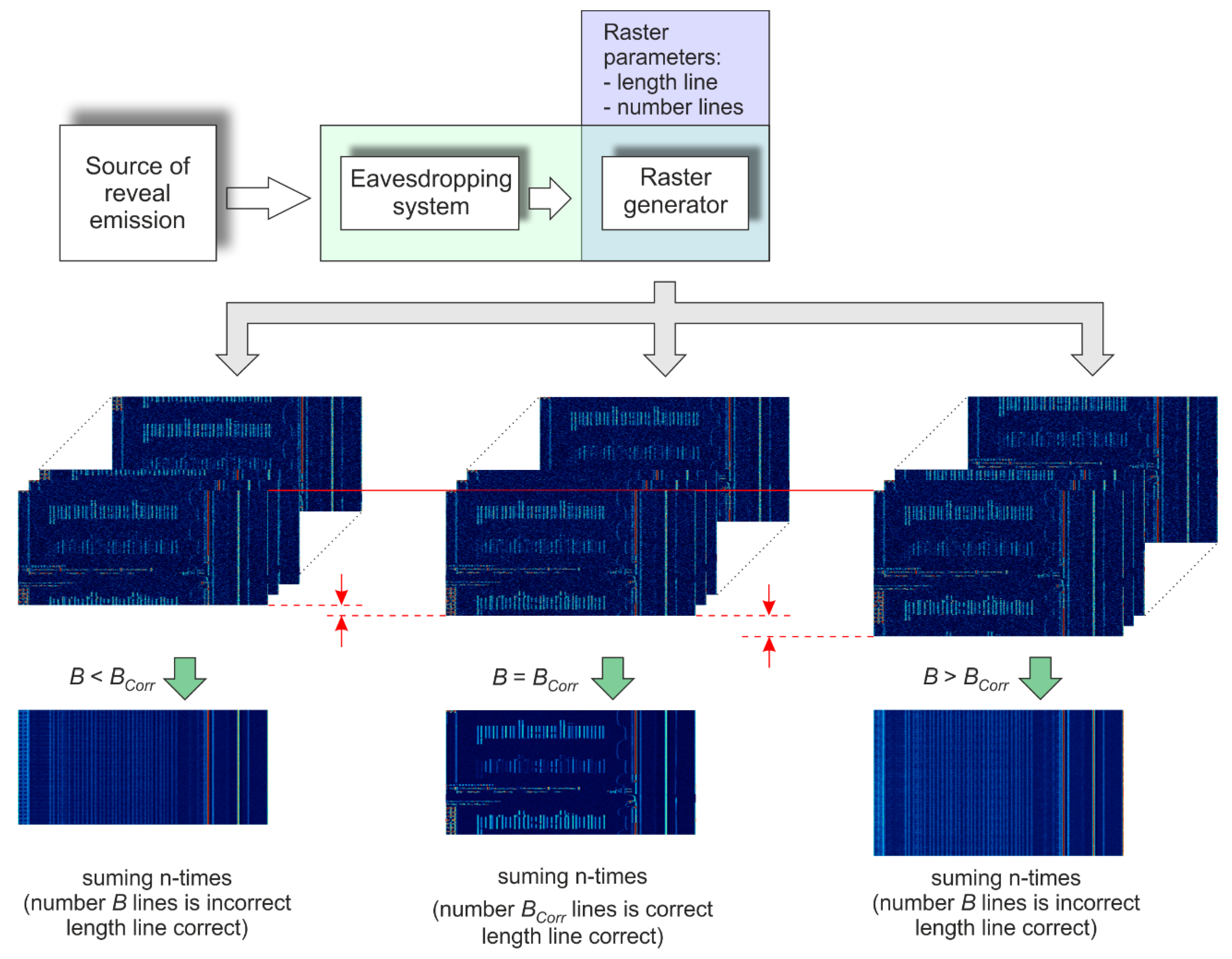
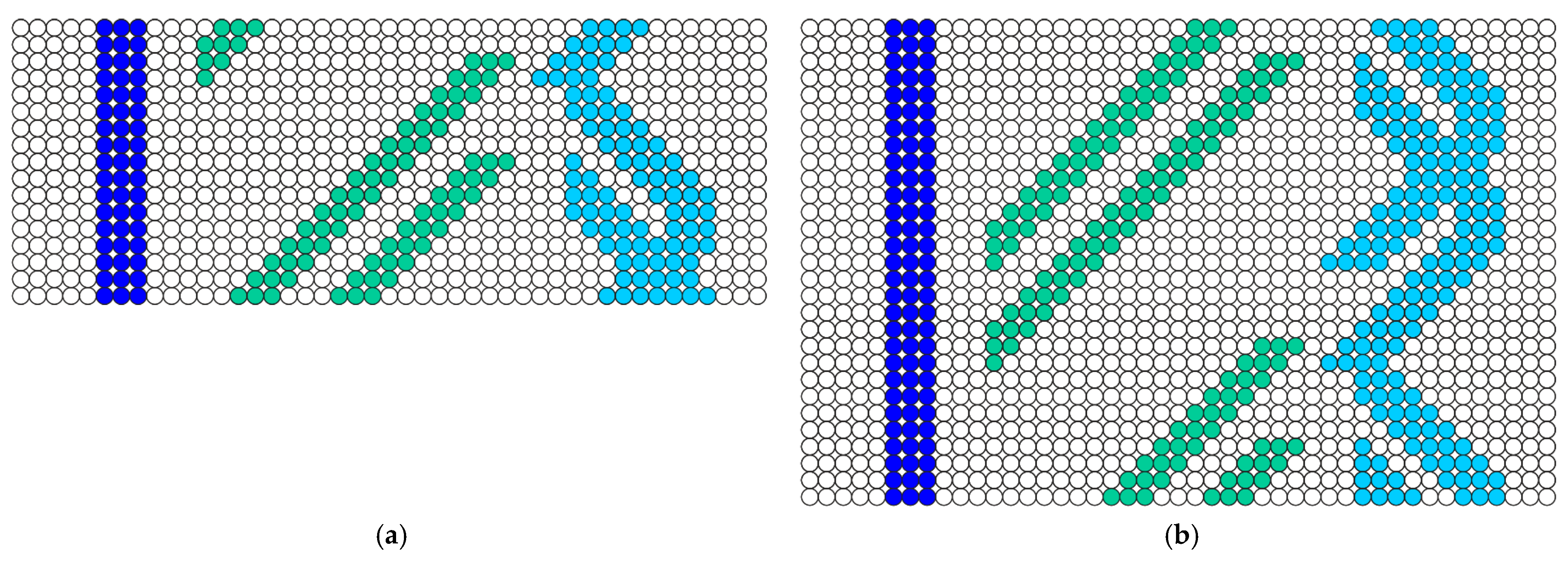


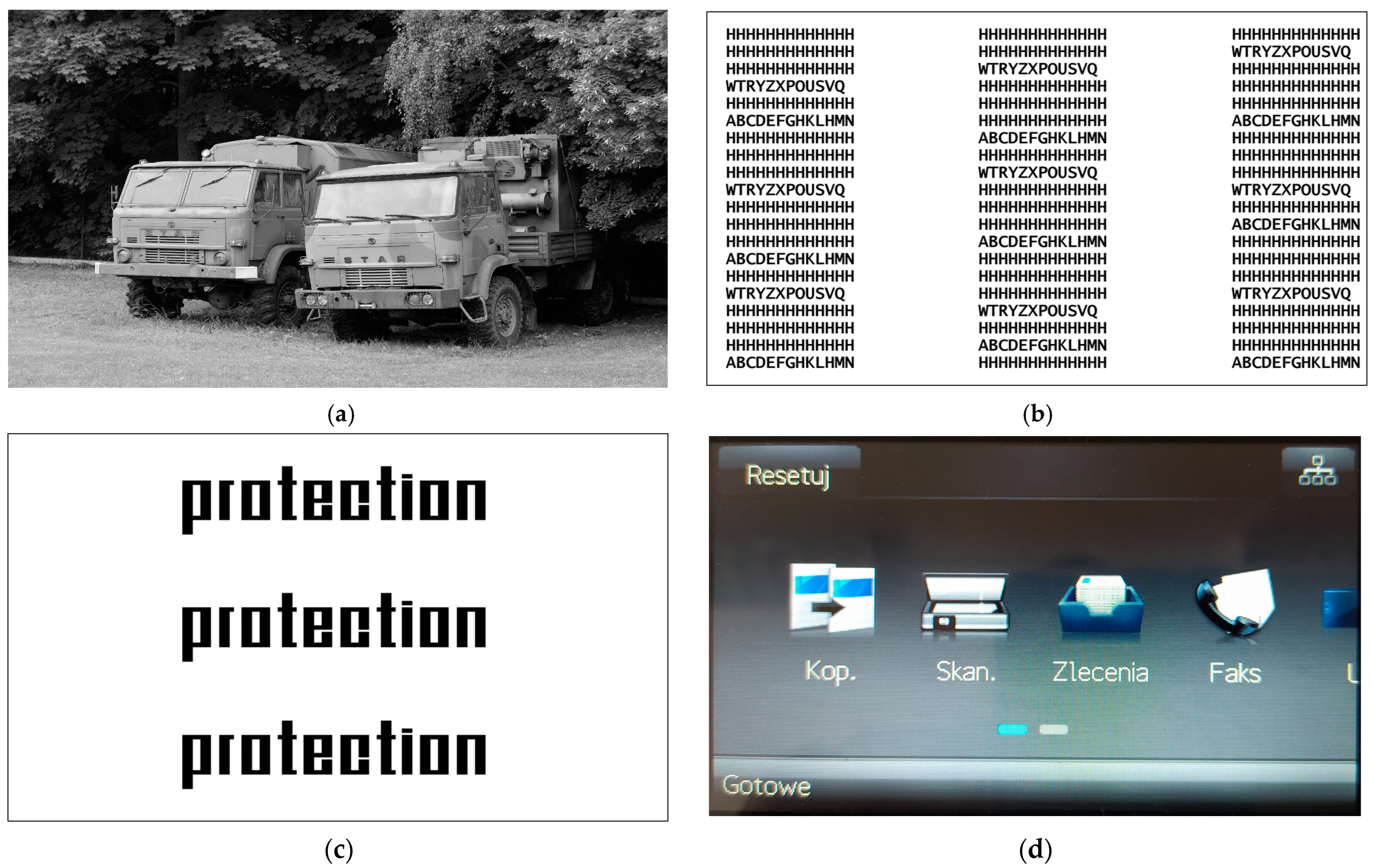
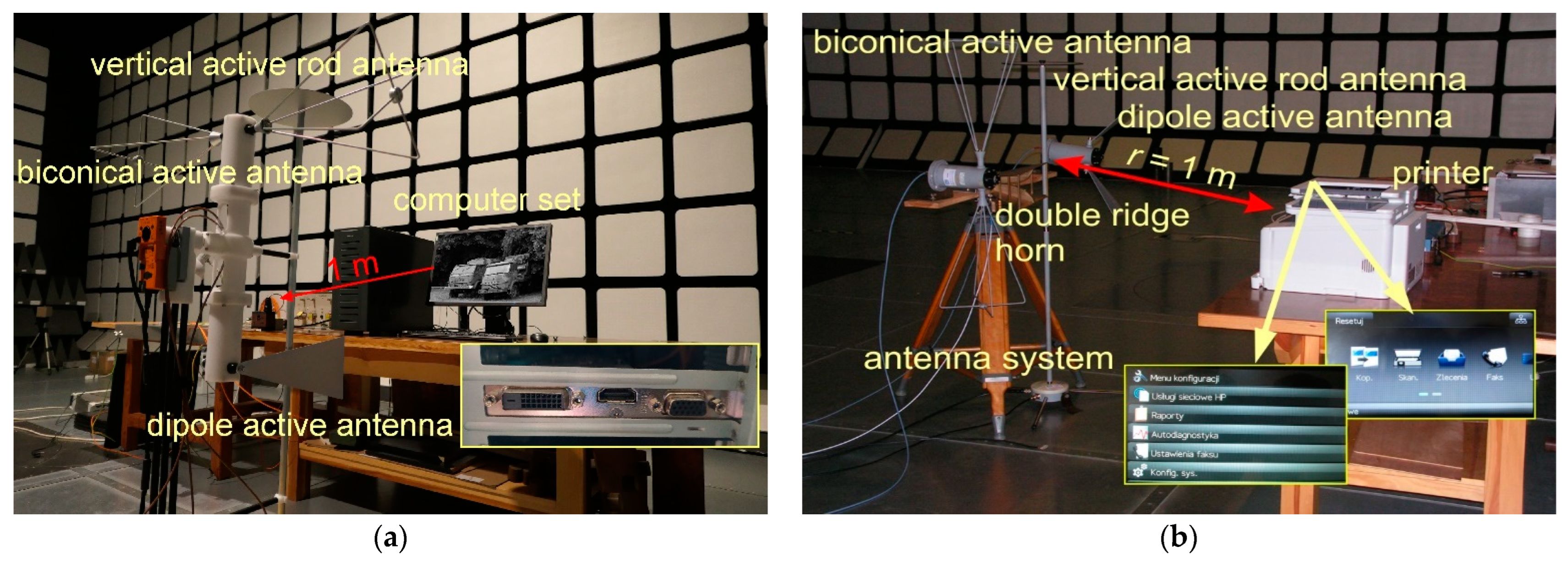
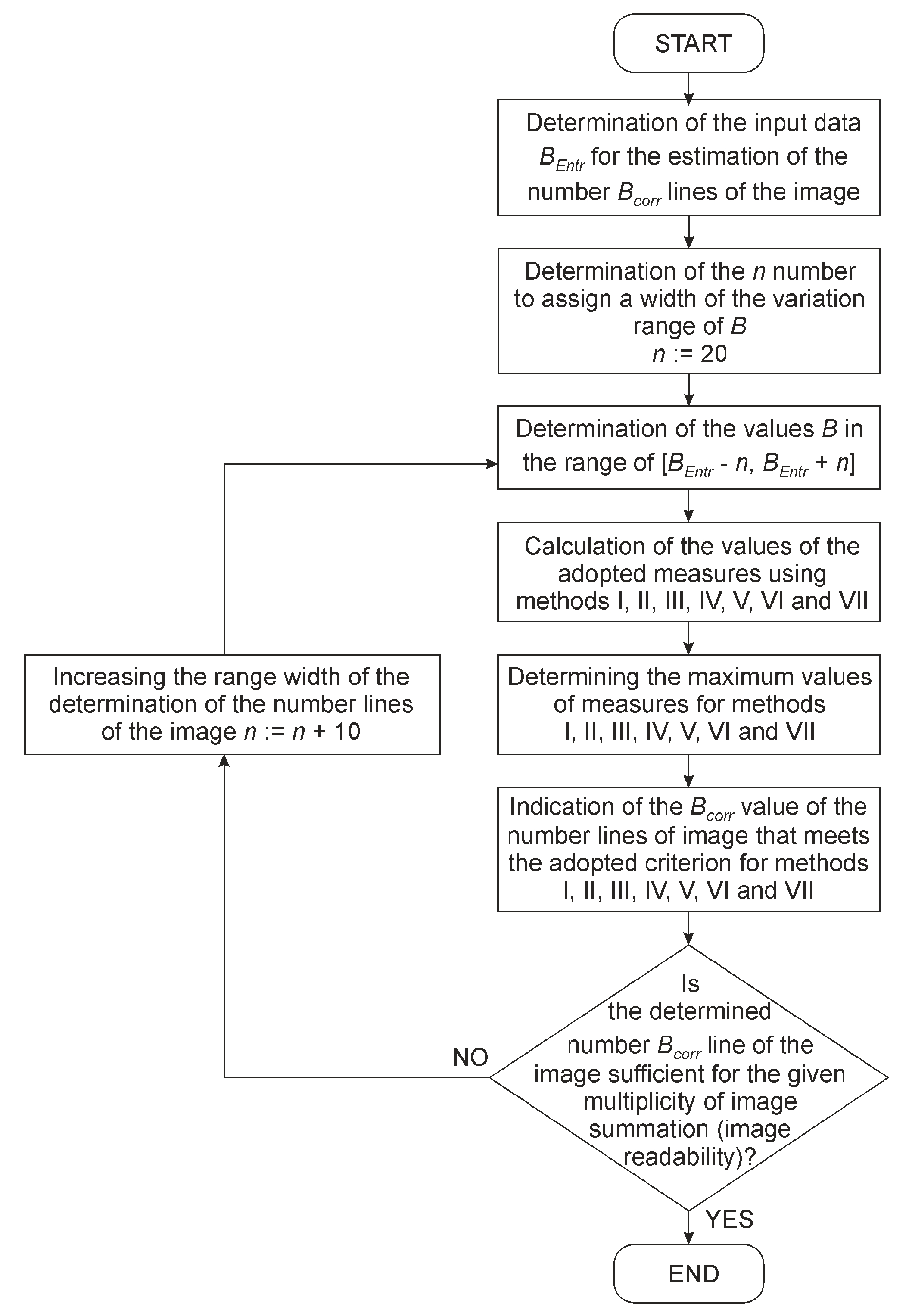

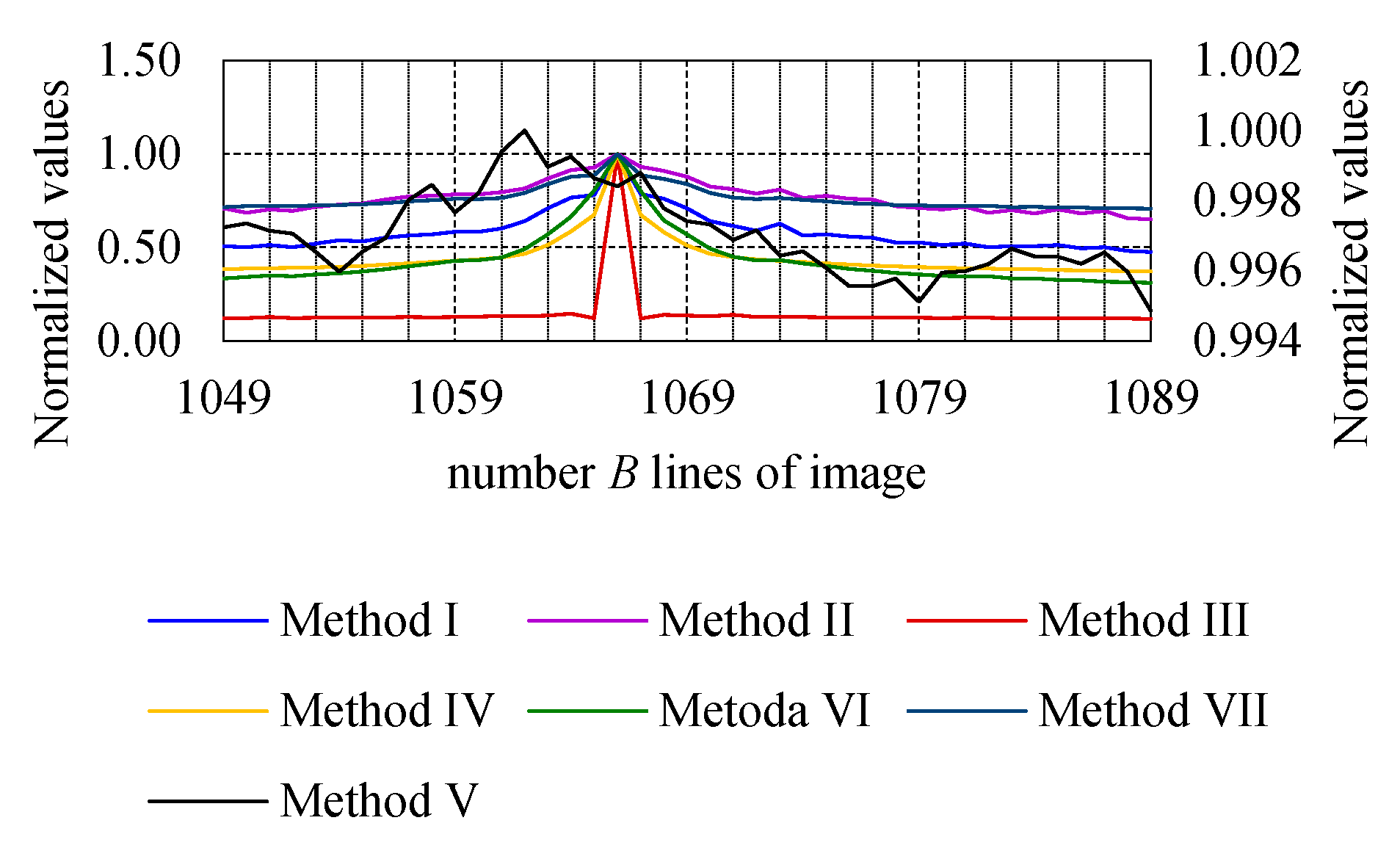

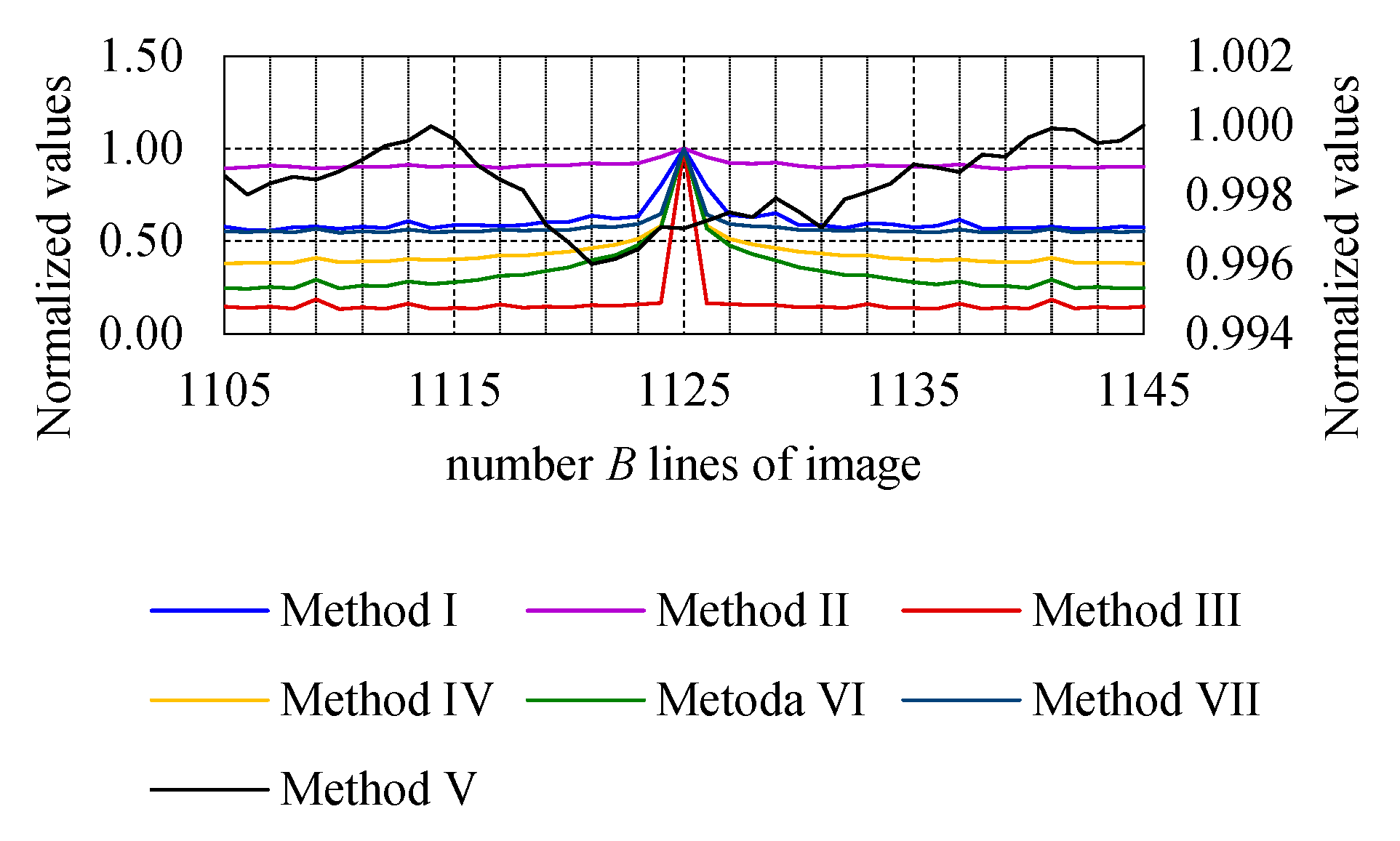


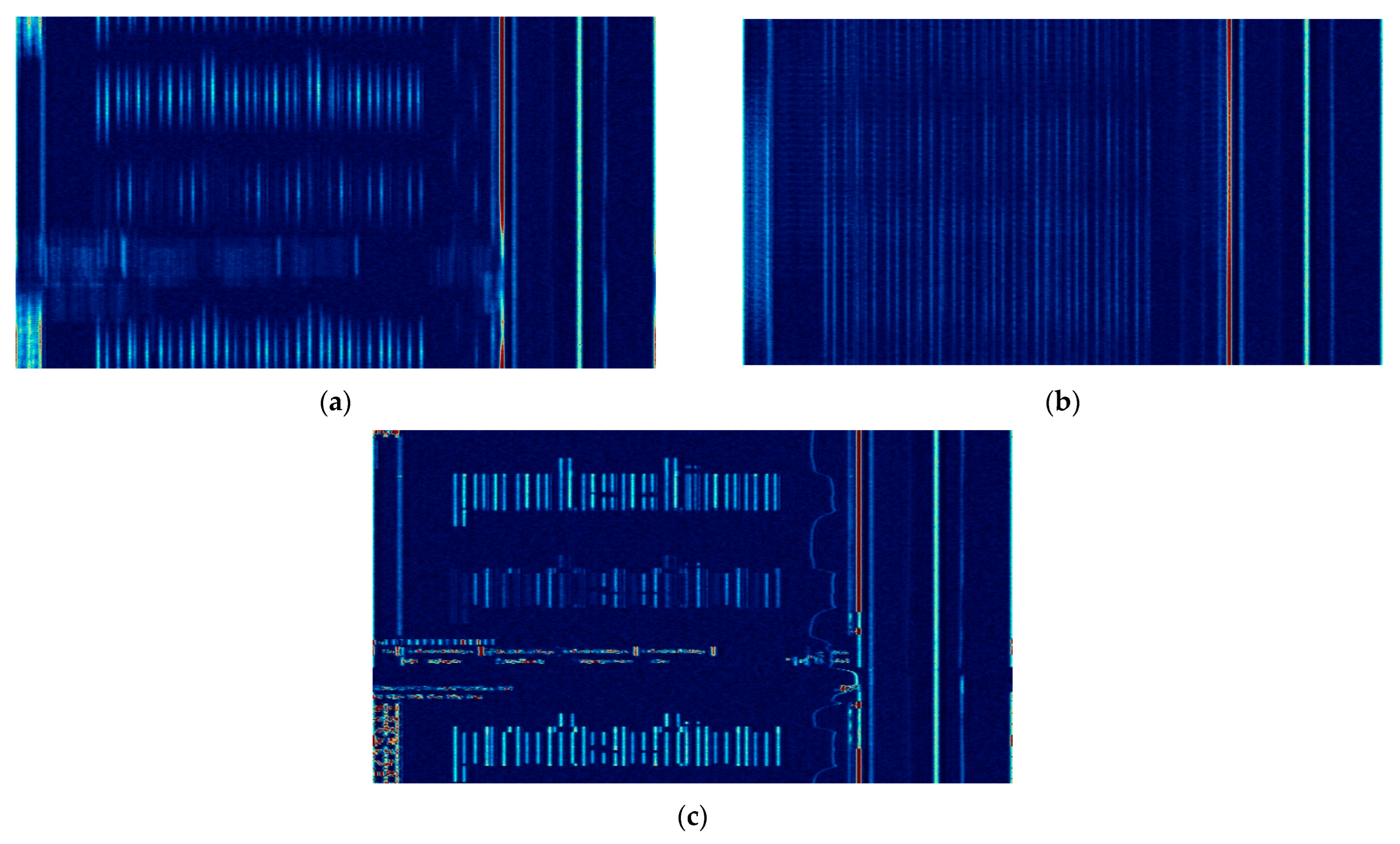
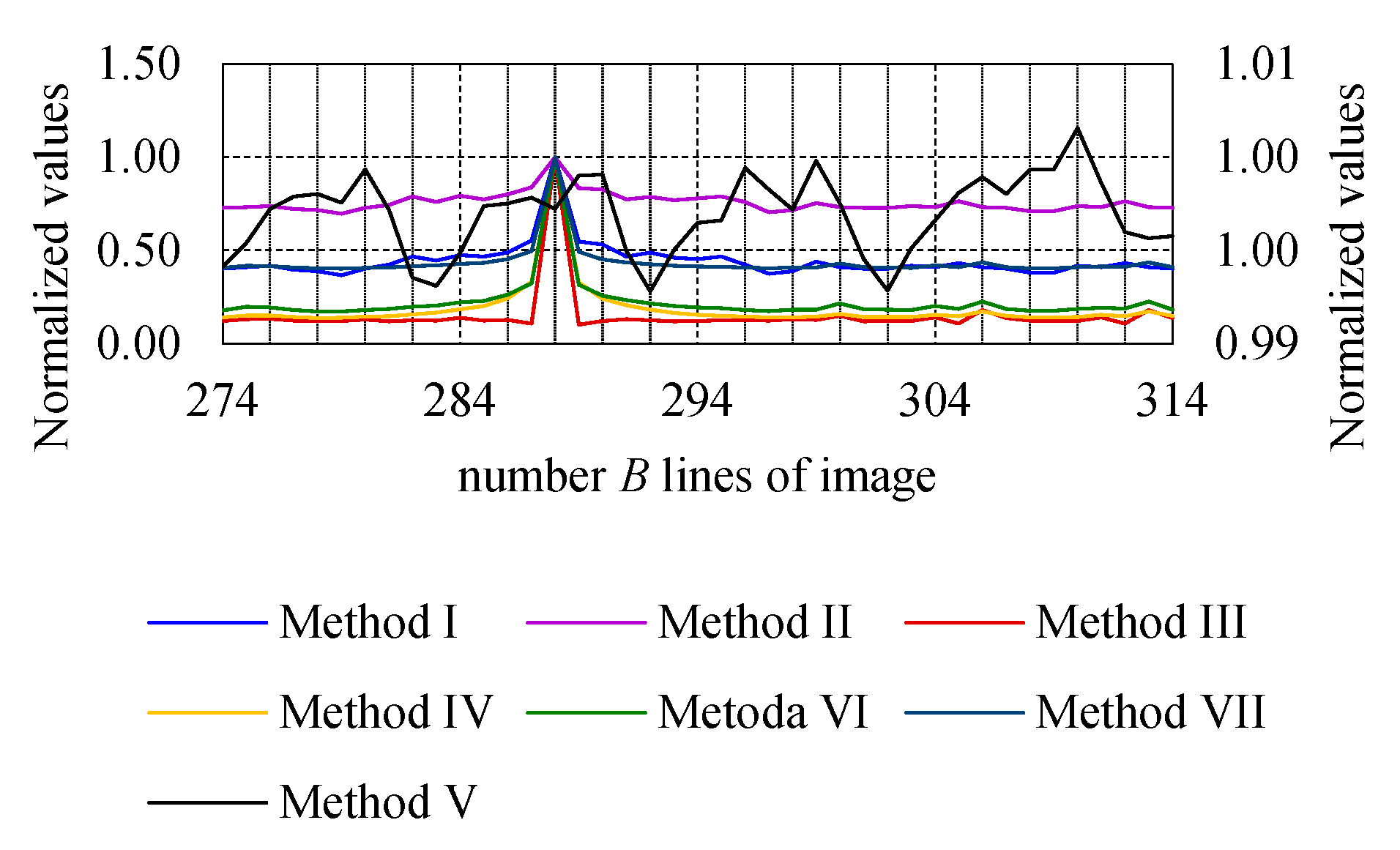

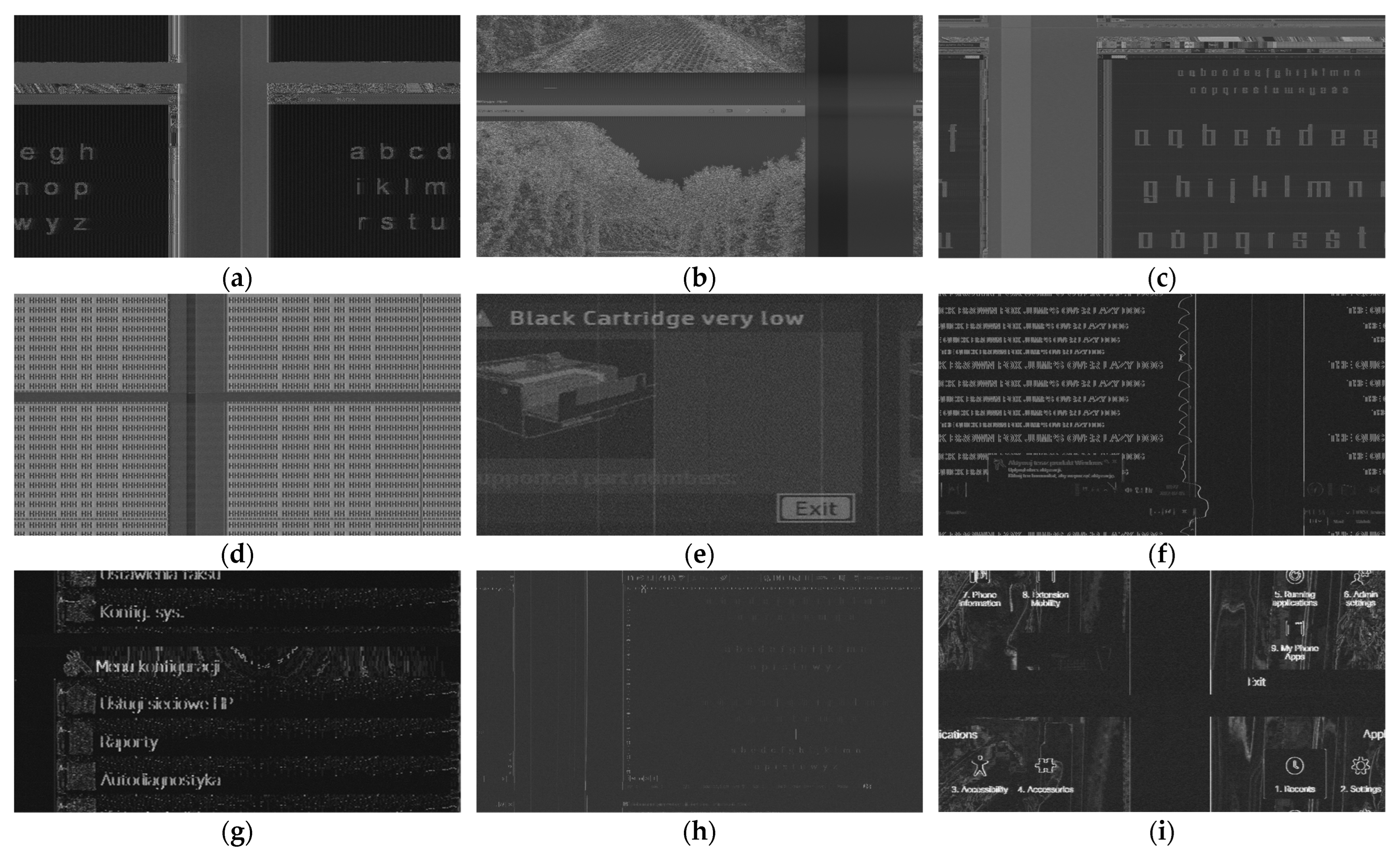
| Number Lines | Method I | Method II | Method III | Method IV | Method V | Method VI | Method VII |
|---|---|---|---|---|---|---|---|
| 1049 | 0.48112 | 0.66368 | 0.12038 | 0.37683 | 0.99667 | 0.31955 | 0.71072 |
| 1050 | 0.48110 | 0.66368 | 0.12021 | 0.37914 | 0.99715 | 0.32650 | 0.71337 |
| 1051 | 0.49375 | 0.68114 | 0.12035 | 0.38169 | 0.99745 | 0.33138 | 0.71521 |
| 1052 | 0.50641 | 0.70756 | 0.11987 | 0.38257 | 0.99724 | 0.33263 | 0.71511 |
| 1053 | 0.50008 | 0.68553 | 0.12118 | 0.38610 | 0.99735 | 0.34176 | 0.71963 |
| 1054 | 0.51276 | 0.70289 | 0.12727 | 0.38881 | 0.99713 | 0.34896 | 0.72230 |
| 1055 | 0.50012 | 0.69427 | 0.12123 | 0.38966 | 0.99706 | 0.34518 | 0.71935 |
| 1056 | 0.51913 | 0.71607 | 0.12294 | 0.39326 | 0.99653 | 0.35504 | 0.72366 |
| 1057 | 0.53815 | 0.72844 | 0.12468 | 0.39653 | 0.99597 | 0.36058 | 0.72539 |
| 1058 | 0.53175 | 0.73354 | 0.12395 | 0.40099 | 0.99654 | 0.36990 | 0.72964 |
| 1059 | 0.55056 | 0.75496 | 0.12560 | 0.40755 | 0.99693 | 0.38265 | 0.73666 |
| 1060 | 0.56307 | 0.77231 | 0.12623 | 0.41467 | 0.99802 | 0.39878 | 0.74565 |
| 1061 | 0.56945 | 0.77611 | 0.12566 | 0.42114 | 0.99845 | 0.41260 | 0.75270 |
| 1062 | 0.58229 | 0.78356 | 0.12731 | 0.42737 | 0.99767 | 0.42734 | 0.75961 |
| 1063 | 0.58216 | 0.78356 | 0.12921 | 0.43537 | 0.99821 | 0.43099 | 0.75837 |
| 1064 | 0.60099 | 0.79440 | 0.13341 | 0.44595 | 0.99939 | 0.44564 | 0.76384 |
| 1065 | 0.63890 | 0.81494 | 0.13197 | 0.46566 | 1.00000 | 0.49005 | 0.79045 |
| 1066 | 0.70862 | 0.86816 | 0.13563 | 0.51140 | 0.99897 | 0.56892 | 0.83785 |
| 1067 | 0.76568 | 0.91229 | 0.14481 | 0.58404 | 0.99926 | 0.66339 | 0.87759 |
| 1068 | 0.77841 | 0.92737 | 0.12076 | 0.67389 | 0.99864 | 0.80281 | 0.88614 |
| 1069 | 1.00000 | 1.00000 | 1.00000 | 1.00000 | 0.99840 | 1.00000 | 1.00000 |
| 1070 | 0.78485 | 0.92983 | 0.11941 | 0.67282 | 0.99878 | 0.80118 | 0.88511 |
| 1071 | 0.75955 | 0.90972 | 0.13853 | 0.58123 | 0.99778 | 0.64458 | 0.86525 |
| 1072 | 0.70892 | 0.87802 | 0.13447 | 0.51034 | 0.99741 | 0.56897 | 0.83815 |
| 1073 | 0.63931 | 0.82458 | 0.13166 | 0.46514 | 0.99732 | 0.49238 | 0.79136 |
| 1074 | 0.61399 | 0.81112 | 0.13834 | 0.44651 | 0.99688 | 0.44840 | 0.76632 |
| 1075 | 0.58869 | 0.78722 | 0.12767 | 0.43508 | 0.99715 | 0.42876 | 0.75767 |
| 1076 | 0.62670 | 0.80825 | 0.12894 | 0.42835 | 0.99642 | 0.43172 | 0.76325 |
| 1077 | 0.56340 | 0.76272 | 0.12668 | 0.42104 | 0.99655 | 0.41378 | 0.75347 |
| 1078 | 0.56973 | 0.77611 | 0.12589 | 0.41452 | 0.99608 | 0.40084 | 0.74680 |
| 1079 | 0.55709 | 0.75886 | 0.12571 | 0.40814 | 0.99556 | 0.38421 | 0.73693 |
| 1080 | 0.55076 | 0.75496 | 0.12554 | 0.40280 | 0.99555 | 0.37415 | 0.73254 |
| 1081 | 0.52544 | 0.72025 | 0.12342 | 0.39780 | 0.99577 | 0.36193 | 0.72628 |
| 1082 | 0.52545 | 0.71130 | 0.12327 | 0.39436 | 0.99512 | 0.35500 | 0.72396 |
| 1083 | 0.51278 | 0.70289 | 0.12137 | 0.39026 | 0.99595 | 0.34622 | 0.72014 |
| 1084 | 0.51911 | 0.71607 | 0.12295 | 0.38815 | 0.99599 | 0.34502 | 0.72043 |
| 1085 | 0.50009 | 0.68553 | 0.12346 | 0.38674 | 0.99619 | 0.34480 | 0.72162 |
| 1086 | 0.50642 | 0.69861 | 0.11976 | 0.38258 | 0.99663 | 0.33250 | 0.71538 |
| 1087 | 0.50640 | 0.68136 | 0.12013 | 0.38166 | 0.99640 | 0.33270 | 0.71585 |
| 1088 | 0.51273 | 0.70289 | 0.11969 | 0.37905 | 0.99640 | 0.32642 | 0.71335 |
| 1089 | 0.49375 | 0.68114 | 0.12204 | 0.37712 | 0.99619 | 0.32428 | 0.71281 |
| Number Lines | Method I | Method II | Method III | Method IV | Method V | Method VI | Method VII |
|---|---|---|---|---|---|---|---|
| 1105 | 0.57762 | 0.89215 | 0.14516 | 0.37915 | 0.99855 | 0.24556 | 0.55184 |
| 1106 | 0.56075 | 0.89722 | 0.13708 | 0.38025 | 0.99800 | 0.24318 | 0.54736 |
| 1107 | 0.55649 | 0.90676 | 0.14503 | 0.38373 | 0.99833 | 0.25174 | 0.55427 |
| 1108 | 0.57335 | 0.90127 | 0.13439 | 0.38217 | 0.99851 | 0.24458 | 0.54638 |
| 1109 | 0.57754 | 0.89215 | 0.18423 | 0.40866 | 0.99843 | 0.29020 | 0.56635 |
| 1110 | 0.56487 | 0.89858 | 0.13218 | 0.38417 | 0.99867 | 0.24414 | 0.54494 |
| 1111 | 0.57752 | 0.90258 | 0.14120 | 0.38847 | 0.99901 | 0.25906 | 0.55138 |
| 1112 | 0.56902 | 0.89993 | 0.13411 | 0.38971 | 0.99940 | 0.25478 | 0.54643 |
| 1113 | 0.60694 | 0.91139 | 0.16184 | 0.40234 | 0.99955 | 0.28113 | 0.56222 |
| 1114 | 0.56900 | 0.89993 | 0.13398 | 0.39623 | 0.99997 | 0.26640 | 0.54818 |
| 1115 | 0.58582 | 0.90517 | 0.13849 | 0.40093 | 0.99960 | 0.27724 | 0.55031 |
| 1116 | 0.58584 | 0.90517 | 0.13491 | 0.40621 | 0.99885 | 0.28810 | 0.55000 |
| 1117 | 0.58169 | 0.89350 | 0.15796 | 0.42220 | 0.99843 | 0.31262 | 0.56130 |
| 1118 | 0.58603 | 0.90517 | 0.13985 | 0.42119 | 0.99813 | 0.31692 | 0.55634 |
| 1119 | 0.60320 | 0.91018 | 0.14516 | 0.43215 | 0.99713 | 0.33761 | 0.55992 |
| 1120 | 0.60339 | 0.91018 | 0.14191 | 0.44263 | 0.99662 | 0.35726 | 0.56085 |
| 1121 | 0.63727 | 0.91953 | 0.15370 | 0.46147 | 0.99601 | 0.39707 | 0.57700 |
| 1122 | 0.62035 | 0.91496 | 0.14898 | 0.47962 | 0.99615 | 0.42268 | 0.57586 |
| 1123 | 0.63299 | 0.91841 | 0.15725 | 0.51080 | 0.99643 | 0.47718 | 0.59181 |
| 1124 | 0.80171 | 0.95558 | 0.16425 | 0.58135 | 0.99707 | 0.57332 | 0.64581 |
| 1125 | 1.00000 | 1.00000 | 1.00000 | 1.00000 | 0.99703 | 1.00000 | 1.00000 |
| 1126 | 0.78902 | 0.95326 | 0.16353 | 0.58082 | 0.99725 | 0.56847 | 0.64176 |
| 1127 | 0.64129 | 0.92065 | 0.15858 | 0.51102 | 0.99749 | 0.47550 | 0.59170 |
| 1128 | 0.62862 | 0.91727 | 0.15249 | 0.48096 | 0.99735 | 0.42839 | 0.58010 |
| 1129 | 0.64968 | 0.92284 | 0.15407 | 0.46193 | 0.99789 | 0.39447 | 0.57593 |
| 1130 | 0.58637 | 0.90517 | 0.14125 | 0.44246 | 0.99751 | 0.35709 | 0.56039 |
| 1131 | 0.58636 | 0.89483 | 0.14507 | 0.43175 | 0.99705 | 0.33826 | 0.56026 |
| 1132 | 0.56944 | 0.89993 | 0.13790 | 0.42055 | 0.99786 | 0.31653 | 0.55444 |
| 1133 | 0.59473 | 0.90770 | 0.15950 | 0.42232 | 0.99807 | 0.31523 | 0.56187 |
| 1134 | 0.59050 | 0.90645 | 0.13854 | 0.40677 | 0.99832 | 0.29376 | 0.55238 |
| 1135 | 0.57357 | 0.90127 | 0.13832 | 0.40079 | 0.99887 | 0.27779 | 0.55003 |
| 1136 | 0.58200 | 0.90389 | 0.13431 | 0.39567 | 0.99878 | 0.26565 | 0.54704 |
| 1137 | 0.61572 | 0.91378 | 0.16145 | 0.40153 | 0.99865 | 0.28136 | 0.56207 |
| 1138 | 0.56508 | 0.89858 | 0.13339 | 0.38904 | 0.99916 | 0.25475 | 0.54625 |
| 1139 | 0.56929 | 0.88941 | 0.14100 | 0.38781 | 0.99910 | 0.25648 | 0.55012 |
| 1140 | 0.56924 | 0.89993 | 0.13318 | 0.38434 | 0.99964 | 0.24651 | 0.54575 |
| 1141 | 0.57766 | 0.90258 | 0.18310 | 0.40838 | 0.99991 | 0.29033 | 0.56573 |
| 1142 | 0.56500 | 0.89858 | 0.13482 | 0.38229 | 0.99987 | 0.24598 | 0.54701 |
| 1143 | 0.56495 | 0.89858 | 0.14440 | 0.38370 | 0.99949 | 0.25112 | 0.55377 |
| 1144 | 0.57760 | 0.90258 | 0.13786 | 0.38086 | 0.99955 | 0.24335 | 0.54738 |
| 1145 | 0.57336 | 0.90127 | 0.14519 | 0.37995 | 1.00000 | 0.24640 | 0.55225 |
| Number Lines | Method I | Method II | Method III | Method IV | Method V | Method VI | Method VII |
|---|---|---|---|---|---|---|---|
| 786 | 0.93999 | 0.97422 | 0.26164 | 0.47097 | 0.99740 | 0.23701 | 0.38126 |
| 787 | 0.94417 | 0.95911 | 0.26043 | 0.47252 | 0.99787 | 0.23726 | 0.38127 |
| 788 | 0.96437 | 0.97559 | 0.26232 | 0.47590 | 0.99821 | 0.23882 | 0.38134 |
| 789 | 0.97254 | 0.96849 | 0.25853 | 0.47973 | 0.99855 | 0.24275 | 0.38286 |
| 790 | 0.98066 | 0.96898 | 0.26950 | 0.48486 | 0.99885 | 0.24939 | 0.38696 |
| 791 | 0.98467 | 0.96922 | 0.25915 | 0.48867 | 0.99928 | 0.24873 | 0.38618 |
| 792 | 0.99664 | 0.98480 | 0.26338 | 0.49419 | 0.99961 | 0.25065 | 0.38699 |
| 793 | 0.98871 | 0.97689 | 0.26055 | 0.49995 | 1.00000 | 0.25727 | 0.39192 |
| 794 | 0.99687 | 0.98480 | 0.26599 | 0.50633 | 0.99950 | 0.26268 | 0.39543 |
| 795 | 0.98504 | 0.96922 | 0.25906 | 0.51268 | 0.99933 | 0.26891 | 0.39989 |
| 796 | 0.98895 | 0.96946 | 0.26829 | 0.52101 | 0.99867 | 0.27769 | 0.40571 |
| 797 | 0.99670 | 0.98480 | 0.26246 | 0.52815 | 0.99800 | 0.27694 | 0.40438 |
| 798 | 0.98889 | 0.97689 | 0.26738 | 0.53642 | 0.99678 | 0.28178 | 0.40657 |
| 799 | 0.99298 | 0.97710 | 0.26344 | 0.54652 | 0.99590 | 0.29121 | 0.41451 |
| 800 | 0.99302 | 0.98462 | 0.26974 | 0.56238 | 0.99541 | 0.30410 | 0.42369 |
| 801 | 0.98905 | 0.96946 | 0.26764 | 0.58427 | 0.99517 | 0.32538 | 0.44039 |
| 802 | 0.98495 | 0.96922 | 0.27374 | 0.61365 | 0.99477 | 0.35233 | 0.46085 |
| 803 | 0.99260 | 0.97710 | 0.27272 | 0.65206 | 0.99423 | 0.38692 | 0.48712 |
| 804 | 0.99624 | 0.98480 | 0.28593 | 0.69870 | 0.99429 | 0.41795 | 0.51159 |
| 805 | 0.99599 | 0.98480 | 0.25964 | 0.75836 | 0.99476 | 0.46916 | 0.55245 |
| 806 | 1.00000 | 0.99256 | 1.00000 | 1.00000 | 0.99502 | 1.00000 | 1.00000 |
| 807 | 0.99208 | 0.97710 | 0.25951 | 0.75794 | 0.99526 | 0.47048 | 0.55397 |
| 808 | 0.99224 | 0.97710 | 0.28464 | 0.69811 | 0.99581 | 0.41896 | 0.51203 |
| 809 | 0.99234 | 0.97710 | 0.27025 | 0.65184 | 0.99613 | 0.38386 | 0.48466 |
| 810 | 0.99217 | 0.97710 | 0.27400 | 0.61508 | 0.99651 | 0.34956 | 0.45882 |
| 811 | 0.99596 | 0.98480 | 0.26738 | 0.58638 | 0.99687 | 0.32565 | 0.44042 |
| 812 | 0.99572 | 0.98480 | 0.27156 | 0.56520 | 0.99729 | 0.30617 | 0.42559 |
| 813 | 0.98782 | 0.97689 | 0.26211 | 0.54867 | 0.99753 | 0.29101 | 0.41444 |
| 814 | 0.99198 | 0.98462 | 0.26691 | 0.53803 | 0.99794 | 0.28382 | 0.40821 |
| 815 | 0.99215 | 0.97710 | 0.26269 | 0.52874 | 0.99835 | 0.27632 | 0.40388 |
| 816 | 0.99234 | 0.97710 | 0.26782 | 0.52114 | 0.99861 | 0.27423 | 0.40329 |
| 817 | 0.99645 | 0.98480 | 0.25994 | 0.51272 | 0.99890 | 0.26746 | 0.39883 |
| 818 | 0.99245 | 0.97710 | 0.26489 | 0.50592 | 0.99929 | 0.26227 | 0.39476 |
| 819 | 0.98845 | 0.96946 | 0.25954 | 0.49942 | 0.99955 | 0.25620 | 0.39169 |
| 820 | 0.98856 | 0.97689 | 0.26432 | 0.49381 | 0.99993 | 0.25080 | 0.38745 |
| 821 | 0.98877 | 0.97689 | 0.25971 | 0.48806 | 0.99920 | 0.24887 | 0.38690 |
| 822 | 0.98492 | 0.96922 | 0.26583 | 0.48423 | 0.99943 | 0.24802 | 0.38685 |
| 823 | 0.99273 | 1.00000 | 0.25788 | 0.47910 | 0.99857 | 0.24196 | 0.38314 |
| 824 | 0.96461 | 0.96799 | 0.26365 | 0.47488 | 0.99815 | 0.24043 | 0.38228 |
| 825 | 0.94880 | 0.97468 | 0.26036 | 0.47078 | 0.99704 | 0.23810 | 0.38149 |
| 826 | 0.93688 | 0.96619 | 0.26205 | 0.46914 | 0.99625 | 0.23997 | 0.38255 |
| Number Lines | Method I | Method II | Method III | Method IV | Method V | Method VI | Method VII |
|---|---|---|---|---|---|---|---|
| 268 | 0.39560 | 0.72202 | 0.12345 | 0.13999 | 0.99729 | 0.17261 | 0.40321 |
| 269 | 0.38852 | 0.71628 | 0.11724 | 0.14128 | 0.99798 | 0.17480 | 0.40424 |
| 270 | 0.39586 | 0.72202 | 0.14957 | 0.16084 | 1.00000 | 0.20340 | 0.42164 |
| 271 | 0.39601 | 0.72202 | 0.10712 | 0.14628 | 0.99764 | 0.18310 | 0.40894 |
| 272 | 0.43179 | 0.76403 | 0.18302 | 0.17021 | 0.99415 | 0.22722 | 0.43696 |
| 273 | 0.41748 | 0.73856 | 0.13408 | 0.14586 | 0.99272 | 0.18691 | 0.41091 |
| 274 | 0.40313 | 0.72765 | 0.12056 | 0.14146 | 0.99411 | 0.17916 | 0.40655 |
| 275 | 0.41022 | 0.73316 | 0.13212 | 0.15153 | 0.99541 | 0.19758 | 0.41777 |
| 276 | 0.41721 | 0.73856 | 0.13409 | 0.15019 | 0.99722 | 0.19331 | 0.41593 |
| 277 | 0.39557 | 0.72202 | 0.12329 | 0.14326 | 0.99789 | 0.18120 | 0.40812 |
| 278 | 0.38845 | 0.71628 | 0.12115 | 0.13882 | 0.99803 | 0.17339 | 0.40374 |
| 279 | 0.36698 | 0.69831 | 0.12118 | 0.13987 | 0.99757 | 0.17336 | 0.40317 |
| 280 | 0.40309 | 0.72765 | 0.12922 | 0.14519 | 0.99934 | 0.18086 | 0.40614 |
| 281 | 0.42473 | 0.74386 | 0.11886 | 0.14716 | 0.99716 | 0.18588 | 0.40893 |
| 282 | 0.46779 | 0.78828 | 0.12500 | 0.15619 | 0.99354 | 0.19800 | 0.41511 |
| 283 | 0.44629 | 0.75913 | 0.12259 | 0.16599 | 0.99310 | 0.20466 | 0.41936 |
| 284 | 0.47511 | 0.79286 | 0.13992 | 0.18488 | 0.99487 | 0.22232 | 0.42804 |
| 285 | 0.46765 | 0.77355 | 0.12281 | 0.20281 | 0.99739 | 0.22925 | 0.43367 |
| 286 | 0.48921 | 0.80176 | 0.12755 | 0.24332 | 0.99752 | 0.26242 | 0.45277 |
| 287 | 0.55386 | 0.83804 | 0.10737 | 0.33133 | 0.99783 | 0.32414 | 0.49738 |
| 288 | 1.00000 | 1.00000 | 1.00000 | 1.00000 | 0.99721 | 1.00000 | 1.00000 |
| 289 | 0.54696 | 0.83428 | 0.10242 | 0.32685 | 0.99902 | 0.31612 | 0.49262 |
| 290 | 0.53273 | 0.82658 | 0.12042 | 0.24105 | 0.99907 | 0.25682 | 0.45063 |
| 291 | 0.46780 | 0.77355 | 0.13092 | 0.20498 | 0.99497 | 0.23382 | 0.43644 |
| 292 | 0.48941 | 0.78718 | 0.12532 | 0.18139 | 0.99280 | 0.21495 | 0.42547 |
| 293 | 0.46072 | 0.76883 | 0.11976 | 0.16428 | 0.99501 | 0.20192 | 0.41816 |
| 294 | 0.45344 | 0.77886 | 0.12064 | 0.15489 | 0.99647 | 0.19389 | 0.41349 |
| 295 | 0.46756 | 0.78828 | 0.12516 | 0.14966 | 0.99661 | 0.19051 | 0.41226 |
| 296 | 0.42435 | 0.75888 | 0.12496 | 0.14412 | 0.99943 | 0.18124 | 0.40757 |
| 297 | 0.37405 | 0.70442 | 0.12349 | 0.14030 | 0.99826 | 0.17469 | 0.40336 |
| 298 | 0.38852 | 0.71628 | 0.13211 | 0.14151 | 0.99718 | 0.18221 | 0.40808 |
| 299 | 0.43900 | 0.75414 | 0.12677 | 0.14409 | 0.99981 | 0.18282 | 0.40906 |
| 300 | 0.41032 | 0.73316 | 0.14947 | 0.15865 | 0.99753 | 0.21579 | 0.42951 |
| 301 | 0.40298 | 0.72765 | 0.11964 | 0.14368 | 0.99453 | 0.18400 | 0.40913 |
| 302 | 0.40303 | 0.72765 | 0.12215 | 0.14211 | 0.99284 | 0.18291 | 0.40781 |
| 303 | 0.41749 | 0.73856 | 0.12221 | 0.14278 | 0.99513 | 0.18106 | 0.40706 |
| 304 | 0.41013 | 0.73316 | 0.14081 | 0.15519 | 0.99662 | 0.20144 | 0.42054 |
| 305 | 0.43161 | 0.76403 | 0.10783 | 0.14623 | 0.99809 | 0.18605 | 0.41077 |
| 306 | 0.40996 | 0.73316 | 0.17973 | 0.17243 | 0.99893 | 0.22547 | 0.43573 |
| 307 | 0.40284 | 0.72765 | 0.13659 | 0.14814 | 0.99804 | 0.18706 | 0.41017 |
| 308 | 0.38140 | 0.71041 | 0.12275 | 0.14026 | 0.99934 | 0.17604 | 0.40453 |
| Source of Reveal Emission | Duration of Displayed Image | Frequency of Reveal Signal Emission | Bandwidth | Number Lines |
|---|---|---|---|---|
| Display of VoIP terminal—menu in form of icons | Unknown | 800 MHz | 20 MHz | 528 |
| Display of HP laser printer M477fdn—menu in form of text | Unknown | 235 MHz | 10 MHz | 288 |
| Display of HP laser printer M477fdn—menu in form of text | Unknown | 235 MHz | 10 MHz | 288 |
| Display of HP laser printer M507—menu in form of icons | Unknown | 392 MHz | 10 MHz | 266 |
| HDMI standard | 1280 × 1024/60 Hz | 1334 MHz | 50 MHz | 1066 |
| 1280 × 1024/60 Hz | 200 MHz | 100 MHz | 1125 | |
| 1280 × 1024/60 Hz | 1334 MHz | 50 MHz | 1066 | |
| DVI standard | 1280 × 1024/60 Hz | 740 MHz | 50 MHz | 628 |
| 1920 × 1080/60 Hz | 1775 MHz | 100 MHz | 1125 | |
| 1280 × 1024/60 Hz | 1805 MHz | 100 MHz | 1066 | |
| 640 × 480/60 Hz | 365 MHz | 50 MHz | 525 | |
| VGA standard | 800 × 600/60 Hz | 450 MHz | 20 MHz | 628 |
| 1024 × 768/60 Hz | 558 MHz | 10 MHz | 806 |
| Figure 7a | Figure 7b | Figure 7c | Figure 7d | |||||
|---|---|---|---|---|---|---|---|---|
| Method I | 1069 | 1066 | 1125 | 1125 | 809 | 806 | 294 | 288 |
| Method II | 1066 | 1125 | 823 | 288 | ||||
| Method III | 1066 | 1125 | 806 | 288 | ||||
| Method IV | 1066 | 1125 | 806 | 288 | ||||
| Method V * | 1062 | 1145 | 793 | 270 | ||||
| Method VI * | 1066 | 1125 | 806 | 288 | ||||
| Method VII * | 1066 | 1125 | 806 | 288 | ||||
| Figure 7a | Figure 7b | Figure 7c | Figure 7d | |
|---|---|---|---|---|
| Method I | 0.51890 | 0.44351 | 0.06312 | 0.63302 |
| Method II | 0.33632 | 0.11059 | 0.04089 | 0.30169 |
| Method III | 0.88059 | 0.86782 | 0.74212 | 0.89758 |
| Method IV | 0.62317 | 0.62085 | 0.53086 | 0.86118 |
| Method V | 0.00488 | 0.00399 | 0.00577 | 0.00728 |
| Method VI | 0.68045 | 0.75682 | 0.76299 | 0.82739 |
| Method VII | 0.28928 | 0.45506 | 0.61874 | 0.59683 |
| Figure 7a | Figure 7b | Figure 7c | Figure 7d | |
|---|---|---|---|---|
| Method I | 0.0114988 | 0.0063718 | 0.0002526 | 0.0096783 |
| Method II | 0.0067733 | 0.0003845 | 0.0000599 | 0.0026803 |
| Method III | 0.0182098 | 0.0174844 | 0.0128797 | 0.0183419 |
| Method IV | 0.0129926 | 0.0104123 | 0.0109060 | 0.0184546 |
| Method V | 0.0000013 | 0.0000012 | 0.0000029 | 0.0000043 |
| Method VI | 0.0221255 | 0.0183717 | 0.0158086 | 0.0162905 |
| Method VII | 0.0039669 | 0.0050373 | 0.0101824 | 0.0084351 |
| Method | Useless | Useless Due to Sensitivity to Disturbances | Useful | Useful Due to Low Computational Complexity |
|---|---|---|---|---|
| Conventional methods | ||||
| Method I | X | |||
| Method II | X | |||
| Method III | X | |||
| Method IV | X | |||
| Method proposed by authors | ||||
| Method V | X | |||
| Method VI | X | X | ||
| Method VII | X | |||
Disclaimer/Publisher’s Note: The statements, opinions and data contained in all publications are solely those of the individual author(s) and contributor(s) and not of MDPI and/or the editor(s). MDPI and/or the editor(s) disclaim responsibility for any injury to people or property resulting from any ideas, methods, instructions or products referred to in the content. |
© 2022 by the authors. Licensee MDPI, Basel, Switzerland. This article is an open access article distributed under the terms and conditions of the Creative Commons Attribution (CC BY) license (https://creativecommons.org/licenses/by/4.0/).
Share and Cite
Kubiak, I.; Przybysz, A.; Grzesiak, K. Number of Lines of Image Reconstructed from a Revealing Emission Signal as an Important Parameter of Rasterization and Coherent Summation Processes. Appl. Sci. 2023, 13, 447. https://doi.org/10.3390/app13010447
Kubiak I, Przybysz A, Grzesiak K. Number of Lines of Image Reconstructed from a Revealing Emission Signal as an Important Parameter of Rasterization and Coherent Summation Processes. Applied Sciences. 2023; 13(1):447. https://doi.org/10.3390/app13010447
Chicago/Turabian StyleKubiak, Ireneusz, Artur Przybysz, and Krystian Grzesiak. 2023. "Number of Lines of Image Reconstructed from a Revealing Emission Signal as an Important Parameter of Rasterization and Coherent Summation Processes" Applied Sciences 13, no. 1: 447. https://doi.org/10.3390/app13010447
APA StyleKubiak, I., Przybysz, A., & Grzesiak, K. (2023). Number of Lines of Image Reconstructed from a Revealing Emission Signal as an Important Parameter of Rasterization and Coherent Summation Processes. Applied Sciences, 13(1), 447. https://doi.org/10.3390/app13010447







